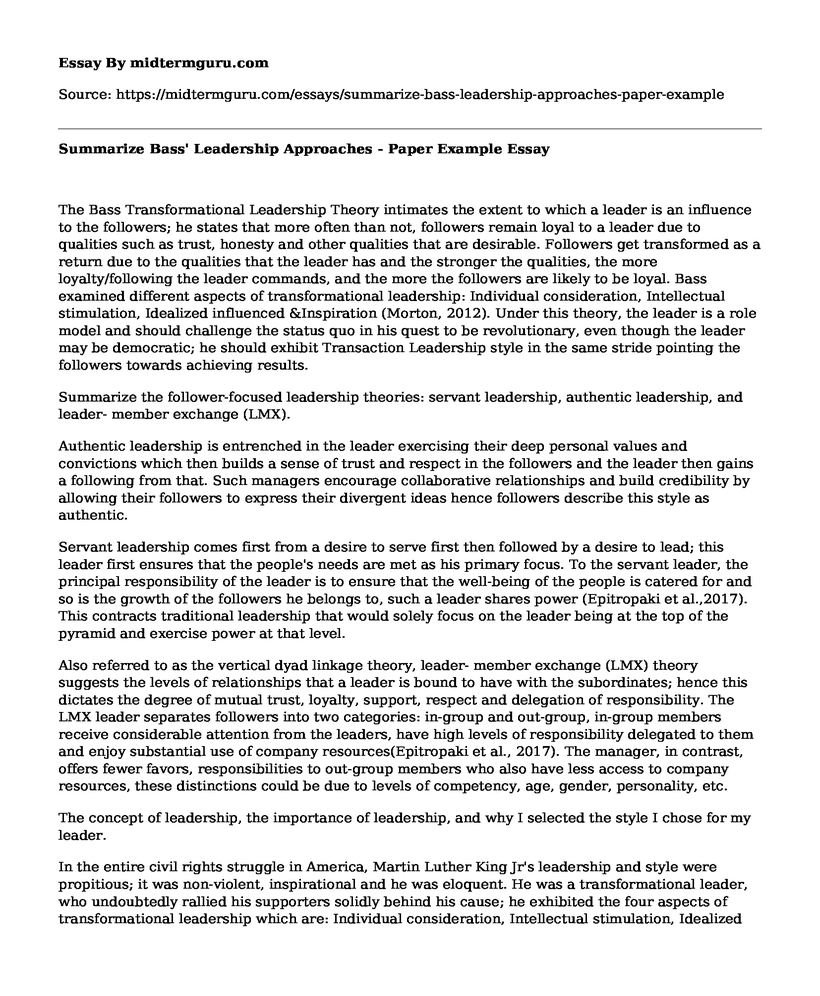The Bass Transformational Leadership Theory intimates the extent to which a leader is an influence to the followers; he states that more often than not, followers remain loyal to a leader due to qualities such as trust, honesty and other qualities that are desirable. Followers get transformed as a return due to the qualities that the leader has and the stronger the qualities, the more loyalty/following the leader commands, and the more the followers are likely to be loyal. Bass examined different aspects of transformational leadership: Individual consideration, Intellectual stimulation, Idealized influenced &Inspiration (Morton, 2012). Under this theory, the leader is a role model and should challenge the status quo in his quest to be revolutionary, even though the leader may be democratic; he should exhibit Transaction Leadership style in the same stride pointing the followers towards achieving results.
Summarize the follower-focused leadership theories: servant leadership, authentic leadership, and leader- member exchange (LMX).
Authentic leadership is entrenched in the leader exercising their deep personal values and convictions which then builds a sense of trust and respect in the followers and the leader then gains a following from that. Such managers encourage collaborative relationships and build credibility by allowing their followers to express their divergent ideas hence followers describe this style as authentic.
Servant leadership comes first from a desire to serve first then followed by a desire to lead; this leader first ensures that the people's needs are met as his primary focus. To the servant leader, the principal responsibility of the leader is to ensure that the well-being of the people is catered for and so is the growth of the followers he belongs to, such a leader shares power (Epitropaki et al.,2017). This contracts traditional leadership that would solely focus on the leader being at the top of the pyramid and exercise power at that level.
Also referred to as the vertical dyad linkage theory, leader- member exchange (LMX) theory suggests the levels of relationships that a leader is bound to have with the subordinates; hence this dictates the degree of mutual trust, loyalty, support, respect and delegation of responsibility. The LMX leader separates followers into two categories: in-group and out-group, in-group members receive considerable attention from the leaders, have high levels of responsibility delegated to them and enjoy substantial use of company resources(Epitropaki et al., 2017). The manager, in contrast, offers fewer favors, responsibilities to out-group members who also have less access to company resources, these distinctions could be due to levels of competency, age, gender, personality, etc.
The concept of leadership, the importance of leadership, and why I selected the style I chose for my leader.
In the entire civil rights struggle in America, Martin Luther King Jr's leadership and style were propitious; it was non-violent, inspirational and he was eloquent. He was a transformational leader, who undoubtedly rallied his supporters solidly behind his cause; he exhibited the four aspects of transformational leadership which are: Individual consideration, Intellectual stimulation, Idealized influenced & Inspiration. Under Idealized influenced, he was a role model who created an anti-racist movement, he did not only talk the talk, he equally walked the talk and as a result was greatly admired by his followers. Inspirational motivation: Martin Luther King was charismatic and by all means motivated and inspired his followers to action (Asselin, 2013). Individualized consideration: Martin Luther showed genuine concern for the oppressed and feelings of the African-Americans, he gave it his all and personal attention. Intellectual stimulation: by creating an unparalleled bipartisan coalition for the anti-racist campaign, he demonstrated that he greatly challenged his followers to achieve greater dreams.
The appropriateness or inappropriateness of the style exhibited by the leader selected.
From his famous speech, I have a dream' Martin Luther comes across as an effective leader coupled with his transformational leadership style discussed herein. The appropriateness of his leadership style comes out in the manner in which he employed charisma; he had transformative speeches that rallied people towards the movement rather than violence (Asselin, 2013). He became a center of balance and unity with tact and the ability to transform the state of minds of his followers even though the benefits of his leadership were felt later after his demise.
References
Asselin, K. C. (2013). Martin Luther King Jr.: Civil Rights Leader. Minneapolis, MN: ABDO Publishing.
Epitropaki, O., Kark, R., Mainemelis, C., & Lord, R. G. (2017). Leadership and followership identity processes: A multilevel review. The Leadership Quarterly, 28104-129. doi:10.1016/j.leaqua.2016.10.003
Morton, W. (2012). Everything You Need to Know About Transformational Leadership. [Newmarket, Ont.]: BrainMass Inc.
Cite this page
Summarize Bass' Leadership Approaches - Paper Example. (2021, Jul 02). Retrieved from https://midtermguru.com/essays/summarize-bass-leadership-approaches-paper-example
If you are the original author of this essay and no longer wish to have it published on the midtermguru.com website, please click below to request its removal:
- Articles Analysis on Changes in Healthcare - Paper Example
- Planning for Termination and Evaluation of Group/Family
- Employment Training: Motivation & Quality Service - Research Paper
- Leadership and Conflict Resolution: Essential for Group Development - Research Paper
- Maximizing Efficiency in Recreation, Sports, Business and Science/Technology - Essay Sample
- Tackling Depression in Older Adults: Engaging All Stakeholders - Research Paper
- Organizational Behavior: Key to Corporate Advantage - Essay Sample







